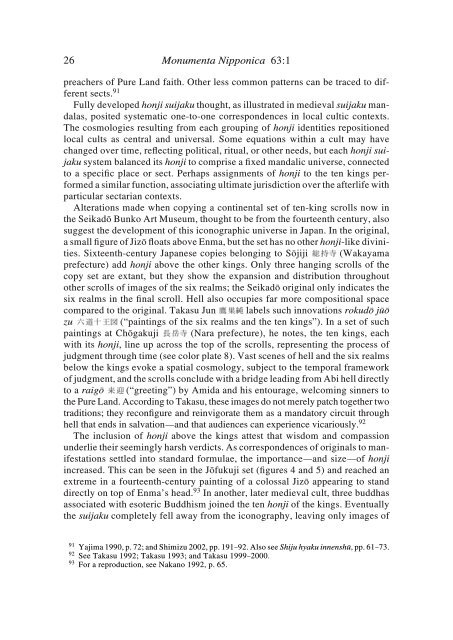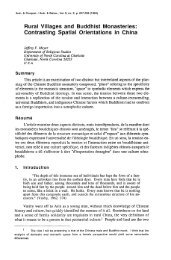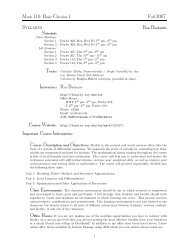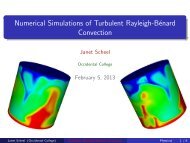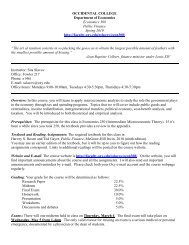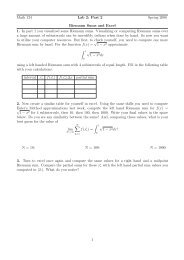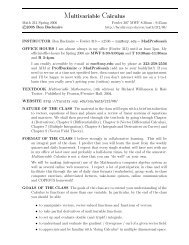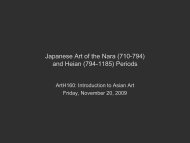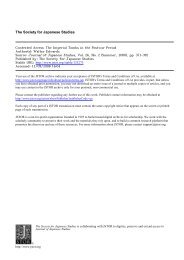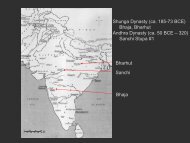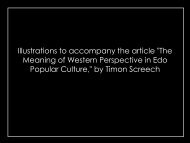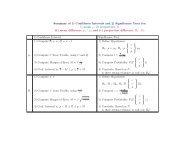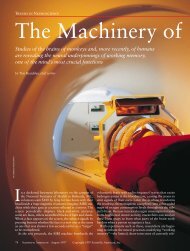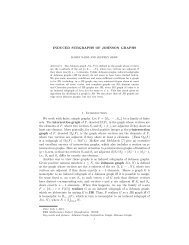A Primer on Japanese Hell Imagery and Imagination - Occidental ...
A Primer on Japanese Hell Imagery and Imagination - Occidental ...
A Primer on Japanese Hell Imagery and Imagination - Occidental ...
Create successful ePaper yourself
Turn your PDF publications into a flip-book with our unique Google optimized e-Paper software.
26<br />
M<strong>on</strong>umenta Nipp<strong>on</strong>ica 63:1<br />
preachers of Pure L<strong>and</strong> faith. Other less comm<strong>on</strong> patterns can be traced to different<br />
sects. 91<br />
Fully developed h<strong>on</strong>ji suijaku thought, as illustrated in medieval suijaku m<strong>and</strong>alas,<br />
posited systematic <strong>on</strong>e-to-<strong>on</strong>e corresp<strong>on</strong>dences in local cultic c<strong>on</strong>texts.<br />
The cosmologies resulting from each grouping of h<strong>on</strong>ji identities repositi<strong>on</strong>ed<br />
local cults as central <strong>and</strong> universal. Some equati<strong>on</strong>s within a cult may have<br />
changed over time, reflecting political, ritual, or other needs, but each h<strong>on</strong>ji suijaku<br />
system balanced its h<strong>on</strong>ji to comprise a fixed m<strong>and</strong>alic universe, c<strong>on</strong>nected<br />
to a specific place or sect. Perhaps assignments of h<strong>on</strong>ji to the ten kings performed<br />
a similar functi<strong>on</strong>, associating ultimate jurisdicti<strong>on</strong> over the afterlife with<br />
particular sectarian c<strong>on</strong>texts.<br />
Alterati<strong>on</strong>s made when copying a c<strong>on</strong>tinental set of ten-king scrolls now in<br />
the Seikadô Bunko Art Museum, thought to be from the fourteenth century, also<br />
suggest the development of this ic<strong>on</strong>ographic universe in Japan. In the original,<br />
a small figure of Jizô floats above Enma, but the set has no other h<strong>on</strong>ji-like divinities.<br />
Sixteenth-century <strong>Japanese</strong> copies bel<strong>on</strong>ging to Sôjiji (Wakayama<br />
prefecture) add h<strong>on</strong>ji above the other kings. Only three hanging scrolls of the<br />
copy set are extant, but they show the expansi<strong>on</strong> <strong>and</strong> distributi<strong>on</strong> throughout<br />
other scrolls of images of the six realms; the Seikadô original <strong>on</strong>ly indicates the<br />
six realms in the final scroll. <strong>Hell</strong> also occupies far more compositi<strong>on</strong>al space<br />
compared to the original. Takasu Jun labels such innovati<strong>on</strong>s rokudô jûô<br />
zu (“paintings of the six realms <strong>and</strong> the ten kings”). In a set of such<br />
paintings at Chôgakuji (Nara prefecture), he notes, the ten kings, each<br />
with its h<strong>on</strong>ji, line up across the top of the scrolls, representing the process of<br />
judgment through time (see color plate 8). Vast scenes of hell <strong>and</strong> the six realms<br />
below the kings evoke a spatial cosmology, subject to the temporal framework<br />
of judgment, <strong>and</strong> the scrolls c<strong>on</strong>clude with a bridge leading from Abi hell directly<br />
to a raigô (“greeting”) by Amida <strong>and</strong> his entourage, welcoming sinners to<br />
the Pure L<strong>and</strong>. According to Takasu, these images do not merely patch together two<br />
traditi<strong>on</strong>s; they rec<strong>on</strong>figure <strong>and</strong> reinvigorate them as a m<strong>and</strong>atory circuit through<br />
hell that ends in salvati<strong>on</strong>—<strong>and</strong> that audiences can experience vicariously. 92<br />
The inclusi<strong>on</strong> of h<strong>on</strong>ji above the kings attest that wisdom <strong>and</strong> compassi<strong>on</strong><br />
underlie their seemingly harsh verdicts. As corresp<strong>on</strong>dences of originals to manifestati<strong>on</strong>s<br />
settled into st<strong>and</strong>ard formulae, the importance—<strong>and</strong> size—of h<strong>on</strong>ji<br />
increased. This can be seen in the Jôfukuji set (figures 4 <strong>and</strong> 5) <strong>and</strong> reached an<br />
extreme in a fourteenth-century painting of a colossal Jizô appearing to st<strong>and</strong><br />
directly <strong>on</strong> top of Enma’s head. 93 In another, later medieval cult, three buddhas<br />
associated with esoteric Buddhism joined the ten h<strong>on</strong>ji of the kings. Eventually<br />
the suijaku completely fell away from the ic<strong>on</strong>ography, leaving <strong>on</strong>ly images of<br />
91 Yajima 1990, p. 72; <strong>and</strong> Shimizu 2002, pp. 191–92. Also see Shiju hyaku innenshû, pp. 61–73.<br />
92 See Takasu 1992; Takasu 1993; <strong>and</strong> Takasu 1999–2000.<br />
93 For a reproducti<strong>on</strong>, see Nakano 1992, p. 65.


